The manual wafer aligner market, valued at USD 207.1 million in 2025, is expected to grow to USD 357.2 million by 2035, reflecting a CAGR of 5.6%. From 2021 to 2025, the market experiences steady growth, moving from USD 157.7 million in 2021 to USD 207.1 million in 2025. During this period, volume growth plays a significant role, as the demand for manual wafer aligners increases due to advancements in semiconductor manufacturing processes. The market moves incrementally through USD 166.6 million in 2022, USD 175.9 million in 2023, USD 185.7 million in 2024, and USD 196.1 million in 2025. Volume growth during these years is primarily driven by the increasing adoption of wafer alignment systems in the semiconductor industry, especially in smaller-scale production and R&D environments.
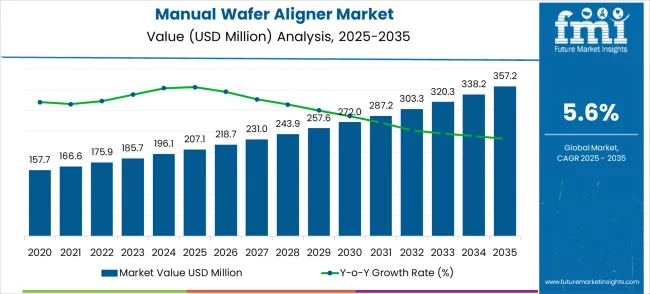
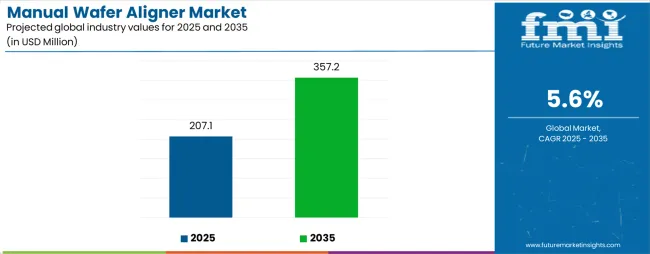
From 2026 to 2030, both volume and price growth contribute to the market's expansion, with the market rising from USD 207.1 million in 2025 to USD 272.0 million in 2030. While volume growth continues to play a major role, the rise in average selling prices (ASPs) also becomes more prominent as manual wafer aligners become more advanced and feature richer capabilities. The shift toward higher-end systems, with enhanced precision and automation features, drives higher prices. By 2035, the market will reach USD 357.2 million, with both volume and price growth continuing to drive market expansion. Increased demand for high-precision semiconductor fabrication and continued technological advancements will lead to sustained increases in both unit sales and average prices over the forecast period.
The semiconductor manufacturing market is the largest contributor, accounting for around 40–45%, as manual wafer aligners are essential in the production of semiconductor devices, where precise alignment of wafers is critical during photolithography and other manufacturing processes. The electronics market follows with a contribution of approximately 20–25%, as the increasing demand for consumer electronics like smartphones, tablets, and wearable devices drives the need for high-quality semiconductors that require wafer alignment during production.
The research and development market represents about 15–18%, as manual wafer aligners are used in laboratories and research facilities for prototyping and developing new materials, devices, and technologies in the semiconductor field. The automotive market accounts for around 10–12%, driven by the growing adoption of advanced electronics and sensors in electric vehicles (EVs) and autonomous systems, where high-performance semiconductors are required. The medical devices market contributes approximately 8–10%, as wafer aligners are used in the production of microelectromechanical systems (MEMS) and other small, precise components used in medical devices.
| Metric | Value |
|---|---|
| Estimated Value in (2025E) | USD 207.1 million |
| Forecast Value in (2035F) | USD 357.2 million |
| Forecast CAGR (2025 to 2035) | 5.6% |
Market expansion is being supported by the increasing global demand for semiconductor devices and the corresponding shift toward manual wafer alignment technologies that can provide superior cost-effectiveness while meeting manufacturing requirements for precision positioning and quality control capabilities. Modern semiconductor manufacturers and wafer processing specialists are increasingly focused on incorporating manual wafer aligners to enhance production efficiency while satisfying demands for advanced positioning technologies and cost-effective processing equipment. Manual wafer aligners' proven ability to deliver superior positioning accuracy, operational flexibility, and cost-effective performance makes them essential equipment for small to medium-scale semiconductor operations and research facility applications.
The growing emphasis on manufacturing cost optimization and production flexibility approaches is driving demand for high-quality manual wafer aligner products that can support distinctive processing experiences and comprehensive positioning control across 200mm wafer processing, research and development, and small-batch production categories. Equipment manufacturer preference for systems that combine positioning excellence with operational cost-effectiveness is creating opportunities for innovative manual implementations in both production and laboratory applications. The rising influence of semiconductor manufacturing diversification and flexible production ecosystems is also contributing to increased adoption of premium manual wafer aligner products that can provide authentic manufacturing integration characteristics.
The manual wafer aligner market represents a rapidly emerging semiconductor equipment opportunity at the intersection of precision manufacturing, wafer processing, and cost-effective automation, with the market projected to expand from USD 207.1 million in 2025 to USD 357.2 million by 2035 at a steady 5.6% CAGR—a 1.7X growth driven by accelerating semiconductor production demand, equipment manufacturer need for cost-effective alignment solutions, and the integration of advanced positioning technology into manual processing equipment.
Pathway A - Wafer Notch Alignment Technology Leadership. The dominant alignment technology offers superior positioning accuracy, consistent wafer orientation, and simplified operator control essential for high-precision applications. Companies developing advanced wafer notch alignment systems with enhanced detection capabilities, improved positioning accuracy, and extended operational duration will capture the leading technology segment. Expected revenue pool: USD 145-165 million.
Pathway B - 200mm Wafer Processing Applications. The largest application segment benefits from growing focus on cost-effective manufacturing and improving production efficiency in medium-scale semiconductor operations. Providers developing comprehensive 200mm wafer alignment solutions with integrated positioning systems, operator training features, and yield optimization capabilities will dominate this primary market. Opportunity: USD 110-135 million.
The market is segmented by alignment type and application. The demand for alignment types is divided into wafer notch aligner, wafer flat aligner, and others. Based on application, the market is categorized into 150mm wafer, 200mm wafer, 300mm wafer, and others.
The wafer notch aligner segment is projected to account for 58.3% of the manual wafer aligner market in 2025, reaffirming its position as the leading alignment technology category. Semiconductor equipment manufacturers and wafer processing providers increasingly utilize wafer notch alignment technology for their superior positioning accuracy, consistent wafer orientation, and ease of operator control in precision manual wafer alignment applications across diverse manufacturing settings. Wafer notch alignment technology's standardized design and proven performance directly address the operational requirements for consistent wafer positioning and reliable orientation control in manual wafer processing operations.
This alignment segment forms the foundation of modern semiconductor processing applications, as it represents the technology with the greatest positioning reliability potential and established compatibility across multiple wafer processing systems. Manufacturer investments in notch detection optimization and positioning mechanism enhancement continue to strengthen adoption among semiconductor equipment producers. With manufacturers prioritizing production accuracy and equipment reliability, wafer notch alignment systems align with both operational effectiveness objectives and cost optimization requirements, making them the central component of comprehensive manual wafer processing strategies.
The segment benefits from continuous technological advancement in notch detection capabilities and growing availability of enhanced positioning systems that enable improved wafer orientation accuracy and operational efficiency at the equipment level. Additionally, semiconductor manufacturers are investing in precision alignment technologies to support production yield improvement and manufacturing cost optimization. As wafer processing continues to evolve and operators seek superior positioning solutions, wafer notch alignment applications will continue to dominate the alignment technology landscape while supporting equipment advancement and manufacturing optimization strategies.
200mm wafer applications are projected to represent the largest share of manual wafer aligner demand in 2025 at 42.1%, underscoring their critical role as the primary application for positioning equipment in medium-scale semiconductor manufacturing and research facility protocols. Equipment manufacturers and process engineers prefer manual wafer alignment systems for their exceptional cost-effectiveness capabilities, precision positioning features, and ability to maintain processing flexibility while supporting diverse production requirements during 200mm wafer processing operations. Positioned as essential equipment for efficient semiconductor manufacturing, manual wafer aligners offer both positioning accuracy and operational cost advantages.
The segment is supported by continuous growth in 200mm wafer production protocols and the growing availability of advanced manual alignment technologies that enable enhanced processing outcomes and yield optimization at the manufacturing facility level. Additionally, semiconductor systems are investing in cost-effective processing technologies to support production efficiency improvement and operational cost optimization. As semiconductor manufacturing continues to evolve and providers seek superior positioning solutions, 200mm wafer applications will continue to dominate the application landscape while supporting technology advancement and manufacturing optimization strategies.
The 200mm segment particularly benefits from the balance between precision requirements and cost considerations that characterize medium-scale semiconductor operations. This wafer size represents an optimal point for manual alignment systems, where the precision demands are manageable through manual operation while the cost benefits compared to fully automated systems remain significant. The segment's growth is further supported by the increasing number of specialty semiconductor manufacturers and research institutions that prefer the flexibility and lower capital investment requirements of manual alignment systems for their 200mm processing needs.
The manual wafer aligner market is advancing steadily due to increasing semiconductor production demand and growing need for cost-effective positioning solutions that emphasize superior manufacturing flexibility across small to medium-scale production and research facility applications. The market faces challenges, including competition from automated alignment systems, technical complexity in precision positioning requirements, and limitations in high-volume production scenarios. Innovation in positioning accuracy enhancement and operator interface improvement continues to influence market development and expansion patterns.
The growing adoption of manual wafer aligners in comprehensive semiconductor manufacturing and research facility applications is enabling equipment manufacturers to develop protocols that provide distinctive cost-effectiveness capabilities while commanding competitive positioning and enhanced production efficiency characteristics. Advanced manufacturing protocols provide superior flexibility while allowing more sophisticated yield optimization across various production categories and processing segments. Manufacturing systems are increasingly recognizing the competitive advantages of manual alignment positioning for comprehensive equipment development and semiconductor specialty market penetration.
Modern manual wafer aligner suppliers are incorporating advanced positioning detection algorithms, precision measurement systems, and alignment optimization technologies to enhance positioning accuracy, improve production outcomes, and meet equipment manufacturer demands for intelligent and reliable wafer alignment solutions. These programs improve equipment performance while enabling new applications, including customized wafer processing and precision positioning systems. Advanced detection integration also allows suppliers to support premium market positioning and operational excellence leadership beyond traditional alignment products.
The semiconductor industry's increasing emphasis on manufacturing flexibility and production cost optimization is driving significant demand for manual wafer alignment systems that offer superior operational adaptability while maintaining precision positioning capabilities. This trend is particularly evident in research and development facilities, small-batch production operations, and specialty semiconductor manufacturers who require equipment that can handle diverse wafer types and processing requirements without the high capital investment associated with fully automated systems. The growing need for equipment that can support multiple wafer sizes and processing protocols within the same facility is creating opportunities for versatile manual alignment solutions that can adapt to changing production demands while maintaining consistent positioning accuracy and operational reliability across different manufacturing scenarios.
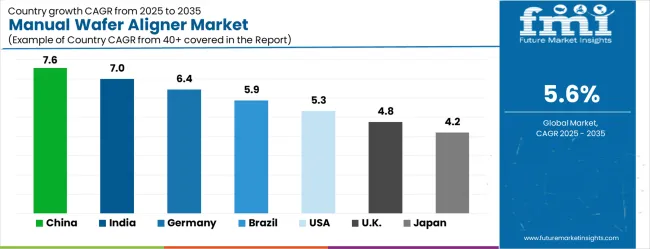
| Country | CAGR (2025 to 2035) |
|---|---|
| China | 7.6% |
| India | 7.0% |
| Germany | 6.4% |
| Brazil | 5.9% |
| U.S. | 5.3% |
| U.K. | 4.8% |
| Japan | 4.2% |
The manual wafer aligner market is experiencing robust growth globally, with China leading at a 7.6% CAGR through 2035, driven by expanding semiconductor manufacturing infrastructure, rising electronics production demand, and increasing adoption of cost-effective processing technologies. India follows at 7.0%, supported by growing technology investments, expanding semiconductor assembly operations, and rising focus on manufacturing cost optimization. Germany shows growth at 6.4%, emphasizing precision manufacturing excellence and advanced equipment development. Brazil demonstrates 5.9% growth, focusing on electronics manufacturing expansion and semiconductor processing capabilities. The U.S. records 5.3%, prioritizing advanced semiconductor manufacturing and comprehensive equipment solutions. The U.K. exhibits 4.8% growth, supported by established technology infrastructure and precision equipment adoption. Japan shows 4.2% growth, focusing on precision manufacturing technology and high-quality semiconductor processing solutions.
The report covers an in-depth analysis of 40+ countries with top-performing countries are highlighted below.
Revenue from manual wafer aligners in China is projected to exhibit exceptional growth with a CAGR of 7.6% through 2035, driven by expanding semiconductor manufacturing infrastructure and rising demand for cost-effective processing equipment across major industrial and technology manufacturing centers. The country's growing electronics production sector and increasing adoption of precision positioning technologies are creating substantial demand for manual wafer alignment solutions in both domestic manufacturing and export-oriented production applications. Major semiconductor equipment manufacturers and processing companies are establishing comprehensive manufacturing and technical support capabilities to serve both domestic production needs and regional export markets.
Rising semiconductor manufacturing development and expanding electronics production capabilities are driving demand for manual wafer aligners across equipment manufacturers, processing facilities, and technology suppliers throughout major Chinese manufacturing systems. Strong government support for technology manufacturing advancement and semiconductor equipment accessibility is supporting the rapid adoption of cost-effective positioning solutions among manufacturers seeking to meet evolving production standards and operational excellence expectations. Growing focus on manufacturing cost optimization and production efficiency improvement is driving the adoption of manual alignment technologies among equipment providers seeking to upgrade to advanced positioning systems and manufacturing excellence standards.
The manual wafer aligners market in India is expanding at a CAGR of 7.0%, supported by growing technology investments, increasing semiconductor assembly operations, and expanding electronics manufacturing infrastructure with cost-effective processing capabilities. The country's developing technology ecosystem and expanding equipment manufacturing sector are driving demand for sophisticated manual wafer positioning products across both urban manufacturing facilities and emerging regional technology centers. International equipment companies and domestic technology manufacturers are establishing comprehensive production and technical support capabilities to address growing market demand for cost-effective positioning solutions.
Demand for manual wafer aligners in Germany is projected to grow at a CAGR of 6.4% through 2035, driven by precision manufacturing excellence initiatives, expanding equipment development capabilities, and growing focus on advanced processing solutions requiring sophisticated positioning technologies. Germany's established manufacturing infrastructure and increasing emphasis on precision equipment development are creating substantial demand for both standard and premium manual wafer aligner varieties. Leading equipment companies and manufacturing specialists are establishing comprehensive technical strategies to serve both German markets and growing European equipment demand.
The manual wafer aligners market in Brazil is projected to grow at a CAGR of 5.9% through 2035, driven by the expansion of domestic electronics manufacturing, increasing localization initiatives, and growing semiconductor packaging and assembly activities. The country is focusing on building capabilities in consumer electronics, telecom components, and automotive semiconductors, creating steady demand for cost-efficient manual wafer aligners. Global OEMs and domestic players are collaborating through partnerships and technology transfer agreements to strengthen the local ecosystem and expand access to wafer alignment technologies.
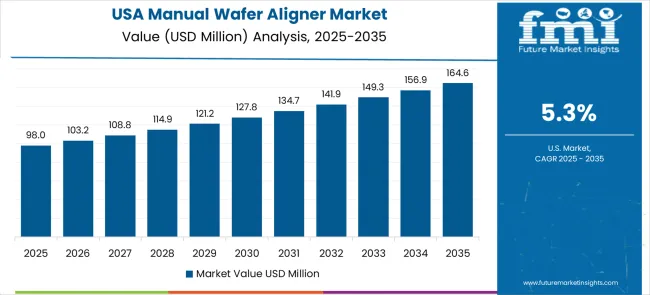
Revenue from manual wafer aligners in the United States is projected to expand at a CAGR of 5.3% through 2035, supported by the country’s focus on advanced semiconductor manufacturing, precision technology infrastructure, and comprehensive equipment solutions. While automation dominates the U.S. semiconductor sector, manual wafer aligners remain relevant for R&D, pilot production lines, and specialized manufacturing where cost-effective precision positioning is required. Strong investments under national semiconductor initiatives further encourage adoption in universities, research facilities, and niche semiconductor processing applications.
Demand for manual wafer aligners in the United Kingdom is expanding at a CAGR of 4.8% through 2035, driven by established technology infrastructure, strong R&D networks, and precision equipment adoption across semiconductor and electronics sectors. The U.K. market emphasizes high-quality manual wafer aligners for advanced research, niche manufacturing, and university-led semiconductor innovation projects. While volume demand is smaller compared to Asia, the U.K. positions itself as a precision-focused market, integrating manual wafer aligners into advanced labs and specialized production environments.
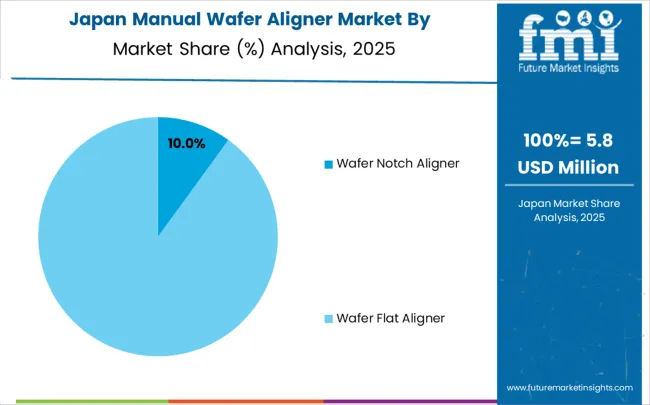
The manual wafer aligners market in Japan is expected to grow at a CAGR of 4.2% through 2035, reflecting the country’s focus on precision manufacturing excellence, high-quality semiconductor processing, and integration of advanced positioning solutions. While automation dominates the Japanese semiconductor sector, manual aligners continue to serve specialized roles in R&D, prototyping, and advanced materials research where accuracy and reliability are critical. Japan’s reputation for manufacturing excellence and technical innovation underpins continued adoption, despite slower growth relative to emerging Asian economies.
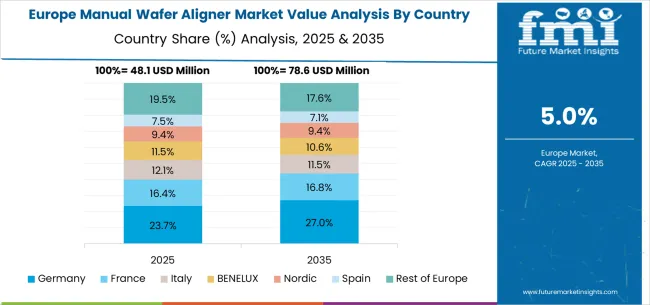
The manual wafer aligner market in Europe is projected to grow at a CAGR of 5.1% from 2025 to 2035. Germany is expected to maintain its leadership position with a 32.1% market share in 2025, declining slightly to 31.8% by 2035, supported by its precision manufacturing sector, advanced equipment development infrastructure, and technical capabilities serving regional and international markets.
The United Kingdom follows with a 18.5% share in 2025, projected to reach 18.2% by 2035, driven by priorities in advanced manufacturing, technical excellence, and precision equipment development. France holds a 16.2% share in 2025, expected to maintain 15.9% by 2035, supported by equipment technology integration and manufacturing adoption, though facing challenges from competition and regulatory dynamics.
Italy accounts for 12.8% in 2025, projected to ease to 12.5% by 2035, while Spain contributes 9.1% in 2025, declining slightly to 8.9% by 2035. The Nordic Countries represent 7.2% in 2025, shifting marginally to 7.1% in 2035, while BENELUX holds 6.2% by 2035. The Rest of Western Europe region is expected to account for 4.2% in 2025, moderating to 4.1% by 2035, reflecting mixed growth dynamics across smaller and mature markets.
The manual wafer aligner market is characterized by competition among established semiconductor equipment companies, specialized positioning system manufacturers, and integrated technology suppliers. Companies are investing in advanced wafer detection technologies, positioning accuracy optimization systems, application-specific product development, and comprehensive technical support capabilities to deliver consistent, high-performance, and reliable manual wafer aligner products. Innovation in positioning precision enhancement, operational efficiency extension, and customized manufacturing compatibility is central to strengthening market position and equipment user satisfaction.
GL Automation leads the market with a significant share, focusing on comprehensive semiconductor equipment solutions and advanced positioning technologies, offering premium manual wafer aligner products with emphasis on operational excellence and precision positioning capabilities. H-Square delivers specialized positioning solutions with emphasis on equipment integration and technical reliability. G2 Automated Technologies focuses on advanced automation solutions with emphasis on precision positioning and operational efficiency. Emu Technologies specializes in semiconductor processing equipment with focus on positioning accuracy and manufacturing reliability.
The competitive landscape is further enriched by companies like SPS-International, which provides integrated manufacturing solutions, and Wafer Handling Systems, which focuses on comprehensive wafer processing equipment. Regional players including Chung King Enterprise, Dou Yee Enterprises, Honwe Precision, Shen-Yueh Technology, Standard Technology, and Suzhou SOSCH Microelectronics contribute to market diversity by offering specialized solutions tailored to specific regional requirements and niche applications.
| Items | Values |
|---|---|
| Quantitative Units (2025) | USD 207.1 million |
| Alignment Type | Wafer Notch Aligner, Wafer Flat Aligner, Others |
| Application | 150mm Wafer, 200mm Wafer, 300mm Wafer, Others |
| Regions Covered | North America, Europe, East Asia, South Asia & Pacific, Latin America, Middle East & Africa |
| Countries Covered | United States, Canada, United Kingdom, Germany, France, China, Japan, South Korea, India, Brazil, Australia and 40+ countries |
| Key Companies Profiled | GL Automation, H-Square, G2 Automated Technologies, Emu Technologies, SPS-International, Wafer Handling Systems |
| Additional Attributes | Dollar sales by alignment type and application, regional demand trends, competitive landscape, technological advancements in wafer positioning, manufacturing integration initiatives, production optimization programs, and operational excellence enhancement strategies |
How big is the manual wafer aligner market in 2025?
The global manual wafer aligner market is valued at USD 207.1 million in 2025.
What will be the size of manual wafer aligner market in 2035?
The size for the manual wafer aligner market is projected to reach USD 357.2 million by 2035.
How much will be the manual wafer aligner market growth between 2025 and 2035?
The manual wafer aligner market is expected to grow at a 5.6% CAGR between 2025 and 2035.
What are the key alignment type segments in the manual wafer aligner market?
The key alignment type segments in the manual wafer aligner market are wafer notch aligner, wafer flat aligner, and others.
Which application segment is expected to contribute significant share in the manual wafer aligner market in 2025?
In terms of application, 200mm wafer segment is set to command 42.1% share in the manual wafer aligner market in 2025.
The global manual wafer aligner market is estimated to be valued at USD 207.1 million in 2025.
The market size for the manual wafer aligner market is projected to reach USD 357.2 million by 2035.
The manual wafer aligner market is expected to grow at a 5.6% CAGR between 2025 and 2035.
The key product types in manual wafer aligner market are wafer notch aligner and wafer flat aligner.
In terms of application, 150mm wafer segment to command 0.0% share in the manual wafer aligner market in 2025.






Our Research Products

The "Full Research Suite" delivers actionable market intel, deep dives on markets or technologies, so clients act faster, cut risk, and unlock growth.

The Leaderboard benchmarks and ranks top vendors, classifying them as Established Leaders, Leading Challengers, or Disruptors & Challengers.

Locates where complements amplify value and substitutes erode it, forecasting net impact by horizon

We deliver granular, decision-grade intel: market sizing, 5-year forecasts, pricing, adoption, usage, revenue, and operational KPIs—plus competitor tracking, regulation, and value chains—across 60 countries broadly.

Spot the shifts before they hit your P&L. We track inflection points, adoption curves, pricing moves, and ecosystem plays to show where demand is heading, why it is changing, and what to do next across high-growth markets and disruptive tech

Real-time reads of user behavior. We track shifting priorities, perceptions of today’s and next-gen services, and provider experience, then pace how fast tech moves from trial to adoption, blending buyer, consumer, and channel inputs with social signals (#WhySwitch, #UX).

Partner with our analyst team to build a custom report designed around your business priorities. From analysing market trends to assessing competitors or crafting bespoke datasets, we tailor insights to your needs.
Supplier Intelligence
Discovery & Profiling
Capacity & Footprint
Performance & Risk
Compliance & Governance
Commercial Readiness
Who Supplies Whom
Scorecards & Shortlists
Playbooks & Docs
Category Intelligence
Definition & Scope
Demand & Use Cases
Cost Drivers
Market Structure
Supply Chain Map
Trade & Policy
Operating Norms
Deliverables
Buyer Intelligence
Account Basics
Spend & Scope
Procurement Model
Vendor Requirements
Terms & Policies
Entry Strategy
Pain Points & Triggers
Outputs
Pricing Analysis
Benchmarks
Trends
Should-Cost
Indexation
Landed Cost
Commercial Terms
Deliverables
Brand Analysis
Positioning & Value Prop
Share & Presence
Customer Evidence
Go-to-Market
Digital & Reputation
Compliance & Trust
KPIs & Gaps
Outputs
Full Research Suite comprises of:
Market outlook & trends analysis
Interviews & case studies
Strategic recommendations
Vendor profiles & capabilities analysis
5-year forecasts
8 regions and 60+ country-level data splits
Market segment data splits
12 months of continuous data updates
DELIVERED AS:
PDF EXCEL ONLINE
Manual Control Valve Market Size and Share Forecast Outlook 2025 to 2035
Manual Lifting Mobile Light Tower Market Size and Share Forecast Outlook 2025 to 2035
Manual Lifting Light Tower Market Size and Share Forecast Outlook 2025 to 2035
Manual Bottle Opener Market Size and Share Forecast Outlook 2025 to 2035
Manual cutting equipment Market Size and Share Forecast Outlook 2025 to 2035
Manual Transmission Market Size and Share Forecast Outlook 2025 to 2035
Manual Resuscitator Market Growth – Size, Trends & Forecast 2024-2034
Instrument Detergents for Manual Cleaning Market Report – Trends & Innovations 2025 to 2035
Wafer Processing Equipment Market Size and Share Forecast Outlook 2025 to 2035
Wafer Level Packaging Market Size and Share Forecast Outlook 2025 to 2035
Wafer Manufacturing Equipment Market Size and Share Forecast Outlook 2025 to 2035
Wafer Inspection Market Size and Share Forecast Outlook 2025 to 2035
Wafer Cleaning Equipment Market Growth - Trends & Forecast 2025 to 2035
Wafer Testing Service Market Growth – Trends & Forecast 2024-2034
Wafer Batch Aligner Market Size and Share Forecast Outlook 2025 to 2035
InP Wafer Market Size and Share Forecast Outlook 2025 to 2035
Thin Wafer Processing and Dicing Equipment Market Size and Share Forecast Outlook 2025 to 2035
Thin Wafers Market Analysis - Size, Demand & Growth 2025 to 2035
Fan-Out Wafer Level Packaging Market Size and Share Forecast Outlook 2025 to 2035
Silicon Epi Wafer Market Size and Share Forecast Outlook 2025 to 2035

Thank you!
You will receive an email from our Business Development Manager. Please be sure to check your SPAM/JUNK folder too.
Chat With
MaRIA